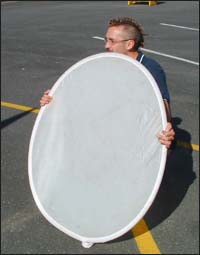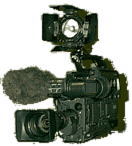Lighting Interviews
The normal rules of lighting apply to interviews. This page covers some general tips specific to interview lighting, whether or not you have your own lights. See our lighting tutorials for more detailed information about lighting technique.

If You Have Your Own Lights
You need to decide whether or not they are actually necessary. Although conventional wisdom says you should control interview lighting yourself if possible, in many situations the existing light will be fine and more practical.
Shooting outside
The weather will obviously influence your decision. If the natural light is sufficient there may be no need to add artificial light. If you do use your own lights you will need to add the appropriate gels to match your lights to the daytime colour temperature. If the sun is too strong you could find a shady location.
Shooting inside
Find the best location - ideally a room with plenty of space and the ability to control existing light. Unless you have a good reason to use existing light sources, try to eliminate them all (close curtains, turn off lights, etc). Then set up your own lights.
If You Have No Lighting

In many situations you are limited to the available light. This is where a reflector board (pictured) can be a lifesaver. Easy to carry and use, it can create useful lighting effects and compensate for unfavourable conditions. If you don't have a reflector board you can sometimes improvise with other reflective objects.
Shooting outside
With luck the natural sunlight will be fine, using the sun as the key light. If the sun is low, be careful not to make the guest squint. Strong sunlight creates strong shadows which can be balanced with a reflector.
Shooting inside
Try to avoid mixed lighting, e.g. sunlight through a window mixed with artificial light. Depending on the strength and quality of light sources, you could either turn the artificial lights off or block out the window light.
Overhead lights aren't desirable as they create ugly shadows on the face. If they are all you have you may be able to balance them with a reflector.
Camera-Mounted Lights

In many situations a light mounted on the camera is all you have. This is common in mobile operations such as news coverage. Although it is a simple, practical solution, it does not produce particularly good lighting and should only really be used when better lighting is not possible.
Note: Lights which draw power from the camera battery will reduce the battery's charge time.
Next Page: Editing Interviews